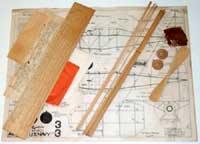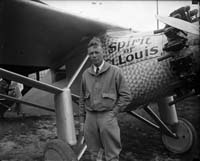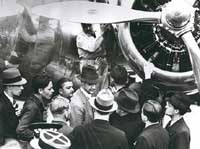
 The year 1938 was a wonderful and important year in my life. The previous summer I fell
madly in love with airplanes and everything associated with flying. I read magazines, built
model planes and cut out every picture in the newspaper and pasted it in a scrapbook, and
there was Jack Armstrong, the "All American Boy" and Jimmy Allen on the radio, the Junior
Birdmen Club in the Detroit Times. Now that scrapbook looks like a history book. It was my
first year at Cass Tech and it was hard to keep my mind on studies with all these
distractions. Plus all those planes flying in the pattern around nearby City Airport. My
head was in the clouds.
The year 1938 was a wonderful and important year in my life. The previous summer I fell
madly in love with airplanes and everything associated with flying. I read magazines, built
model planes and cut out every picture in the newspaper and pasted it in a scrapbook, and
there was Jack Armstrong, the "All American Boy" and Jimmy Allen on the radio, the Junior
Birdmen Club in the Detroit Times. Now that scrapbook looks like a history book. It was my
first year at Cass Tech and it was hard to keep my mind on studies with all these
distractions. Plus all those planes flying in the pattern around nearby City Airport. My
head was in the clouds.
The NAA Model Airplane Nationals were again held at Wayne County Airport and at the
Grosse Ile blimp hanger. It was the year of the gas powered Zipper, Carl Goldberg's creation
that flew straight up like a rocket beating all competition. The rest of the Chicago
Aeronauts team painted their planes with multi-colored polka dots sprayed on all the
surfaces. They were very distinct and easy to spot. Their team also won the championship.
Wally Simmers also introduced his Jabberwock that year. Contest headquarters was the Fort
Wayne hotel in downtown Detroit on Cass and Lafayette. Buses provided transportation.
 In the world of the big birds, two eventful flights made the headlines. The first had to do
with a young Irish mechanic and pilot named Doug. Eleven years earlier this Californian
worked at the Ryan Aircraft Co. in San Diego when the company was building a custom airplane
for Col. Charles Lindbergh. The Spirit of St. Louis was actually a modification of the 1926
Ryan M-1 Brougham, a five seat open cabin monoplane with a 200 hp. Wright J-4B Whirlwind
engine. The spirit used a J-5 with 237 hp. Lindbergh worked and closely supervised the
project and kept pushing it ahead. Interestingly, the one piece wing was built on the second
floor of the plant. Getting it down meant going through a wide window out onto the top of a
boxcar from where it was finally lowered to the ground. Lindy even helped push the car out
of the way. There was a great haste in construction because several pilots and companies
were in a race to be the first to build and fly their craft. The Ryan NYP was completed in
60 days, quickly test flown and left for New York with never having been fully fueled until
the epic flight. Anyway, back to Doug. He was caught up in the frenzy of the Atlantic flight
and thought he could do the same. This was a period in time when record flights were
frequently being made. A Curtis Robin stayed aloft in 1929 for 420 hours, and a year later
another one stayed up for 647 hours and 28 minutes. This was the plane to get. So finally
Doug bought a used Robin for $900. This 3 place plane with Curtis Challenger 180 hp. engine
was ideally the right machine to make the flight. He tinkered with it until it ticked like a
clock. He fitted it with long range fuel tanks in the fuselage and in July 1938 he left for
New York nonstop. The trip was successful and he was ready for the next leg, nonstop to
Dublin, Ireland. He went to the U.S. Dept. of Commerce for permission to make the trip. He
was denied. He tried again, again he was denied. The reason given was that this nine year
old "Jallopy" was incapable of safely completing such a trip. A disappointed and dejected
pilot reluctantly refuelled the plane and announced that he was heading back to California.
In the world of the big birds, two eventful flights made the headlines. The first had to do
with a young Irish mechanic and pilot named Doug. Eleven years earlier this Californian
worked at the Ryan Aircraft Co. in San Diego when the company was building a custom airplane
for Col. Charles Lindbergh. The Spirit of St. Louis was actually a modification of the 1926
Ryan M-1 Brougham, a five seat open cabin monoplane with a 200 hp. Wright J-4B Whirlwind
engine. The spirit used a J-5 with 237 hp. Lindbergh worked and closely supervised the
project and kept pushing it ahead. Interestingly, the one piece wing was built on the second
floor of the plant. Getting it down meant going through a wide window out onto the top of a
boxcar from where it was finally lowered to the ground. Lindy even helped push the car out
of the way. There was a great haste in construction because several pilots and companies
were in a race to be the first to build and fly their craft. The Ryan NYP was completed in
60 days, quickly test flown and left for New York with never having been fully fueled until
the epic flight. Anyway, back to Doug. He was caught up in the frenzy of the Atlantic flight
and thought he could do the same. This was a period in time when record flights were
frequently being made. A Curtis Robin stayed aloft in 1929 for 420 hours, and a year later
another one stayed up for 647 hours and 28 minutes. This was the plane to get. So finally
Doug bought a used Robin for $900. This 3 place plane with Curtis Challenger 180 hp. engine
was ideally the right machine to make the flight. He tinkered with it until it ticked like a
clock. He fitted it with long range fuel tanks in the fuselage and in July 1938 he left for
New York nonstop. The trip was successful and he was ready for the next leg, nonstop to
Dublin, Ireland. He went to the U.S. Dept. of Commerce for permission to make the trip. He
was denied. He tried again, again he was denied. The reason given was that this nine year
old "Jallopy" was incapable of safely completing such a trip. A disappointed and dejected
pilot reluctantly refuelled the plane and announced that he was heading back to California.
A full day went by with no word of his whereabouts. Everyone wondered what happened to him.
Finally on the next day the news came out. He had landed in Ireland. He was warmly greeted
by his fellow Irish folks and the news rapidly flashed around the world. Questioned by the
press about what happened since he was headed for California, he replied, "I went the wrong
way." He stuck with that story and suddenly Wrong Way Corrigan became an international hero.
An embarassed Dept. of Commerce had to punish this flagrant act, so they suspended his
pilot's license for the length of time it took for him and his plane to return to the U.S.
by boat.
 During this same time another American was making a historic long flight. Howard Hughes with
a crew of four was circling the globe in his Lockheed 14 transport plane. Landing back in
New York on July 14th after a flight of 3 days, 19 hours and 14 minutes for a new world's
record. He was greeted by N.Y. mayor La Guardia and received a great ovation from the city
and the nation, but the greater acclaim went to the young Irish lad who flew the Atlantic
alone. Howard, of course, with his wealth went on to grander adventures in Hollywood and in
other aviation events including owning TWA and building the Spruce Goose, which got him in
big trouble with the government.
During this same time another American was making a historic long flight. Howard Hughes with
a crew of four was circling the globe in his Lockheed 14 transport plane. Landing back in
New York on July 14th after a flight of 3 days, 19 hours and 14 minutes for a new world's
record. He was greeted by N.Y. mayor La Guardia and received a great ovation from the city
and the nation, but the greater acclaim went to the young Irish lad who flew the Atlantic
alone. Howard, of course, with his wealth went on to grander adventures in Hollywood and in
other aviation events including owning TWA and building the Spruce Goose, which got him in
big trouble with the government.
Dough Corrigan spent the rest of the summer touring the country visiting all the large cities.
He arrived in Detroit one sunny day in mid-August and a crowd of thousands swarmed around him
and his airplane. The police were totally overwhelmed because only a dozen or so of them were
present. The following morning the police were well prepared for the expected multitutde, it
seemed that half the force was out to control the event. This time the crowd consisted of
about a dozen or so people. They had completely miscalculated the whole mission. Walking back
home that day with my friend we were amused by the turn of events that occured.
This is what I remember the most of that year so long ago.
Len Marzewski
Past President
EAA Chapter 113
 The year 1938 was a wonderful and important year in my life. The previous summer I fell
madly in love with airplanes and everything associated with flying. I read magazines, built
model planes and cut out every picture in the newspaper and pasted it in a scrapbook, and
there was Jack Armstrong, the "All American Boy" and Jimmy Allen on the radio, the Junior
Birdmen Club in the Detroit Times. Now that scrapbook looks like a history book. It was my
first year at Cass Tech and it was hard to keep my mind on studies with all these
distractions. Plus all those planes flying in the pattern around nearby City Airport. My
head was in the clouds.
The year 1938 was a wonderful and important year in my life. The previous summer I fell
madly in love with airplanes and everything associated with flying. I read magazines, built
model planes and cut out every picture in the newspaper and pasted it in a scrapbook, and
there was Jack Armstrong, the "All American Boy" and Jimmy Allen on the radio, the Junior
Birdmen Club in the Detroit Times. Now that scrapbook looks like a history book. It was my
first year at Cass Tech and it was hard to keep my mind on studies with all these
distractions. Plus all those planes flying in the pattern around nearby City Airport. My
head was in the clouds.


